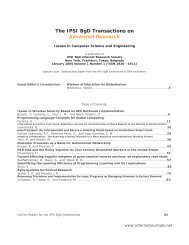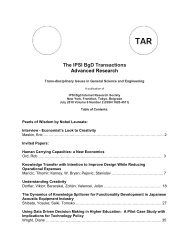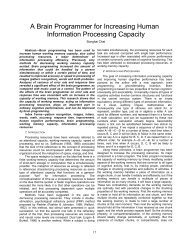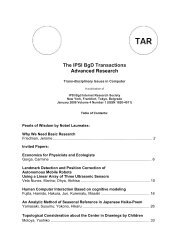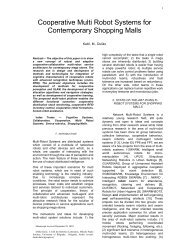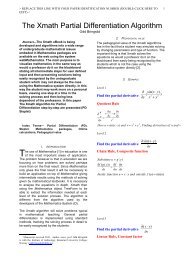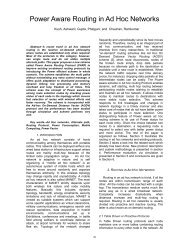Submited Paper (click here to see)
Submited Paper (click here to see)
Submited Paper (click here to see)
You also want an ePaper? Increase the reach of your titles
YUMPU automatically turns print PDFs into web optimized ePapers that Google loves.
dures, among which the most important are:<br />
(1) maut: that implements questionnaires that<br />
can be analysed using MAUT, (2) ahp: that<br />
implements questionnaires that can be<br />
analysed using AHP, (3) logging: that<br />
implements the GOMS analysis, log analysis<br />
and the GOMS-log integration.<br />
visnu<br />
gui<br />
validation<br />
util<br />
usability<br />
measures is depicted in Fig. 2.<br />
Table 2. Criteria <strong>to</strong> be analysed in the planning<br />
phase<br />
Subject<br />
Application<br />
domain<br />
System<br />
Developmen<br />
t phase<br />
Criteria <strong>to</strong> be analysed<br />
● Critical domains<br />
● Validation criteria<br />
● End-user profile<br />
● Division in sub-systems<br />
● Uncertainty management<br />
● Type of output variables<br />
● Type of problem in hand<br />
● Relationship with the<br />
environment<br />
● Initial phases<br />
● Intermediate phases<br />
● Final phases<br />
gui<br />
planning<br />
measures<br />
interpretation<br />
maut<br />
ahp<br />
logging<br />
Data cases<br />
Validation<br />
strategies<br />
Fig. 1. VISNU modules.<br />
The following sections will describe the<br />
validation and usability modules in more detail.<br />
2.2 Validation module<br />
The validation module in VISNU was<br />
developed on the basis of previous work<br />
performed by the authors on the validation <strong>to</strong>ol<br />
SHIVA (System for Heuristic and Integrated<br />
Validation) [21]. This <strong>to</strong>ol was designed<br />
according <strong>to</strong> a methodology that divided the<br />
process in<strong>to</strong> three phases, namely, planning,<br />
application, and interpretation.<br />
2.3 Planning<br />
With a view <strong>to</strong> determining the most suitable<br />
validation strategies, the planning phase involves<br />
an analysis of the system characteristics, the<br />
application domain and the development phase.<br />
Table 2 shows the criteria that are analysed in<br />
the validation planning process. For example, if<br />
the outputs of the system follow an ordinal scale,<br />
the most suitable approach is <strong>to</strong> weight the<br />
discrepancies according <strong>to</strong> importance (for<br />
example, in the symbolic processing of a given<br />
variable, a discrepancy between the categories<br />
‘very high’ and ‘slightly high’ is not quite the same<br />
as between the categories ‘very high’ and ‘very<br />
low’). Weighted kappa or the within-one agreement<br />
index are highly appropriate measures for<br />
taking discrepancies in<strong>to</strong> account. Further details<br />
of the planning module are <strong>to</strong> be found in [21].<br />
2.4 Application<br />
The application phase applies the strategies<br />
identified in the planning phase by making<br />
quantitative measurements using test data. The<br />
procedure for calculating the different quantitative<br />
Initial process<br />
Pair measures<br />
calculation<br />
Group measures<br />
calculation<br />
Contingency<br />
tables<br />
Pair<br />
measures<br />
Group<br />
measures<br />
Fig. 2. Procedure for obtaining quantitative<br />
validation measures.<br />
The first step is <strong>to</strong> analyse the existing test<br />
cases according <strong>to</strong> the validation strategies<br />
identified in the planning phase. This initial<br />
analysis permits us <strong>to</strong> construct contingency<br />
tables that correlate the interpretations of each of<br />
the possible pairs that can be formed between<br />
the experts that participate in the validation<br />
process (including the intelligent system).<br />
Contingency tables will serve as the basis for<br />
the construction of pair measures, such as kappa<br />
or the agreement index, that provide an index<br />
that quantifies coincidences between the<br />
interpretations of two experts. Fig. 3 illustrates a<br />
contingency table and the pair tests obtained<br />
from it.<br />
These pair measures can be used as input for<br />
the calculation of group measures, such as<br />
cluster analysis or MDS [22] (Multi-Dimensional<br />
Scaling) the objective of which is <strong>to</strong> analyse<br />
<strong>to</strong>gether the interpretations of the experts and <strong>to</strong><br />
endeavour <strong>to</strong> find representation structures that<br />
permit an easier interpretation within the context<br />
of the validation. In Fig. 4 we can <strong>see</strong> a bubble<br />
graph that integrates clustering information with<br />
MDS information.<br />
40




